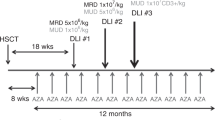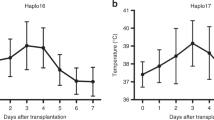Abstract
the purpose of the study was to evaluate the effect of lisofylline (lsf) on engraftment, regimen-related toxicities (rrt), and mortality in patients undergoing allogeneic bone marrow transplantation (bmt). we performed a multicenter, randomized placebo-controlled trial in 60 patients with hematologic malignancies receiving bmt from hla-identical sibling donors. patients were randomized to receive either placebo, 2 mg/kg lsf or 3 mg/kg lsf every 6 h, beginning before conditioning and continuing to day 21 or hospital discharge. treatment groups were balanced with respect to conditioning regimen and disease stage. however, significantly more patients in the 2 mg/kg lsf group were at high risk for rrt due to performance status ⩾1, age ⩾40 years, and prior exposure to cmv. nausea and vomiting were the only adverse events observed in a higher proportion of lsf-treated patients that led to study withdrawal in six of 42 patients (14%). the times to neutrophil recovery to ⩾500/μl and platelet recovery (>20 000/μl) were not improved by LSF treatment. Nevertheless, no patient who received treatment with 3 mg/kg LSF developed a documented infection between day 0 and 35 or had a serious or fatal infection between day 0 and 100 (P = 0.003 vs placebo for both). The day-100 survival rate was also significantly improved in the 3 mg/kg LSF group (89%), compared with either the 2 mg/kg LSF (48%) or placebo (61%) groups (log-rank test, 3 mg/kg LSF vs placebo, P = 0.026). We conclude that treatment with LSF 3 mg/kg reduced the incidence of infections and improved 100-day survival in patients receiving related-donor allogeneic bone marrow transplantation. Bone Marrow Transplantation (2000) 25, 283–291.
This is a preview of subscription content, access via your institution
Access options
Subscribe to this journal
Receive 12 print issues and online access
$259.00 per year
only $21.58 per issue
Buy this article
- Purchase on Springer Link
- Instant access to full article PDF
Prices may be subject to local taxes which are calculated during checkout



Similar content being viewed by others
References
Holler E, Kolb HJ, Moller A et al. Increased serum levels of tumor necrosis factor alpha precede major complications of bone marrow transplantation Blood 1990 75: 1011–1016
Nestel FP, Price KS, Seemayer TA, Lapp WS . Macrophage priming and lipopolysaccharide-triggered release of tumor necrosis factor alpha during graft-versus-host disease J Exp Med 1992 175: 405–413
Sonis S, Lindquist L, Van Vugt A et al. Prevention of chemotherapy-induced ulcerative mucositis by transforming growth factor beta 3 Cancer Res 1994 54: 1135–1138
Maze R, Sherry B, Kwon BS et al. Myelosuppressive effects in vivo of purified recombinant murine macrophage inflammatory protein-1 alpha J Immunol 1992 149: 1004–1009
Metcalf D . Hematopoietic regulators: redundancy or subtlety? Blood 1993 82: 3515 (review)
Holler E, Kolb H, Hintermeier-Knabe R et al. Role of tumor necrosis factor alpha in acute graft-versus-host disease and complications following allogeneic bone marrow transplantation Transplant Proc 1993 25: 1234–1236
Antin JH, Ferrara JL . Cytokine dysregulation and acute graft-versus-host disease Blood 1992 80: 2964–2968
Anscher M, Peters W, Reisenbichler H et al. Transforming growth factor beta as a predictor of liver and lung fibrosis after autologous bone marrow transplantation for advanced breast cancer New Engl J Med 1993 328: 1592–1598
Herve P, Flesch M, Tiberghien P et al. Phase I–II trial of a monoclonal anti-tumor necrosis factor alpha antibody for the treatment of refractory severe acute graft-versus-host disease Blood 1992 79: 3362–3368
Hill GR, Crawford JM, Cooke KR et al. Total body irradiation and acute graft-versus-host disease: the role of gastrointestinal damage and inflammatory cytokines Blood 1997 90: 3204–3213
Khan BV, Parthasarathy SS, Alexander RW, Medford RM . Modified low density lipoprotein and its constituents augment cytokine-activated vascular cell adhesion molecule-1 gene expression in human vascular endothelial cells J Clin Invest 1995 95: 1262–1270
Marks JD, Marks CB, Luce JM et al. Plasma tumor necrosis factor in patients with septic shock. Mortality rate, incidence of adult respiratory distress syndrome, and effects of methylprednisolone administration Am Rev Resp Dis 1999 141: 94–97
Riikonen P, Saarinen UM, Teppo AM et al. Cytokine and acute-phase reactant levels in serum of children with cancer admitted for fever and neutropenia J Infect Dis 1992 166: 432–436
Steinmetz HT, Herbertz A, Bertram M, Diehl V . Increase in interleukin-6 serum level preceding fever in granulocytopenia and correlation with death from sepsis J Infect Dis 1995 171: 225–228
Netea MG, Kullberg BJ, Blok WL et al. The role of hyperuricemia in the increased cytokine production after lipopolysaccharide challenge in neutropenic mice Blood 1997 89: 577–582
Clarke E, Rice GC, Weeks RS et al. Lisofylline inhibits transforming growth factor beta release and enhances trilineage hematopoietic recovery after 5-fluorouracil treatment in mice Cancer Res 1996 56: 105–112
Rice G, Rosen J, Weeks R et al. CT-1501R selectively inhibits induced inflammatory monokines in human whole blood ex vivo Shock 1994 1: 254–266
de Vries P, Xu Z, Rice G, Singer J . In vivo therapy with lisofylline (LSF) in mice suppresses the ex vivo release of multi-lineage hematopoietic inhibitory activity induced by cancer chemotherapeutic agents (chemo) from murine splenocytes Blood 1996 88: 114b (Abstr.)
Wattanasirichaigoon S, Menconi MJ, Delude RL, Fink MP . Lisofylline ameliorates ilial ischemia/reperfusion-induced mucosal barrier dysfunction in rats Dig Dis Weekly (in press)
Cicalese L, Yacoub W, Rogers J et al . Protective effect of lisofylline on bacterial translocation Transplantation (in press)
Teicher B . Lisofylline as an adjuvant to high dose cytotoxic therapy Int J Cancer (in press)
Abraham E, Bursten S, Shenkar R et al. Phosphatidic acid signaling mediates lung cytokine expression and lung inflammatory injury after hemorrhage in mice J Exp Med 1995 181: 569–575
Waxman K, Daughters K, Aswani S, Rice G . Lisofylline decreases white cell adhesiveness and improves survival after experimental hemorrhagic shock Crit Care Med 1996 24: 1724–1728
Hasegawa N, Oka Y, Nakayama M et al. The effects of post-treatment with lisofylline, a phosphatidic acid generation inhibitor, on sepsis-induced acute lung injury in pigs Am J Respir Crit Care Med 1997 155: 928–936
List A, Shuster M, Blazar B et al. Phase I concentration-controlled, escalation trial of lisofylline (LSF) in patients (PTS) undergoing allogeneic bone marrow transplantation (BMT) Blood 1994 84: 89a (Abstr.)
Klaus S, Coon M, Bright J et al . Lisofylline inhibits induction of EAE and Th1 differentiation by blocking IL-121 signaling and IFN-gamma secretion Keystone Symposium on Molecular and Cellular Biology 1997 4042: (Abstr.)
Bearman SI, Appelbaum FR, Buckner CD et al. Regimen-related toxicity in patients undergoing bone marrow transplantation J Clin Oncol 1988 6: 1562–1568
Chao N, Schmidt G, Niland J et al. Cyclosporine, methotrexate, and prednisone compared with cyclosporine and prednisone for prophylaxis of acute graft-versus-host disease New Engl J Med 1993 329: 1225–1230
Thomas ED, Storb R, Clift RA et al. Bone-marrow transplantation (second of two parts) New Engl J Med 1975 292: 895–902
Kaplan E, Meier P . Nonparametric estimation from incomplete observations J Am Stat Assoc 1958 53: 457–459
Klingemann HG, Storb R, Fefer A et al. Bone marrow transplantation in patients aged 45 years and older Blood 1986 67: 770–776
Clift RA, Buckner CD, Appelbaum FR et al. Allogeneic marrow transplantation in patients with acute myeloid leukemia in first remission: a randomized trial of two irradiation regimens Blood 1990 76: 1867–1871
McDonald GB, Hinds MS, Fisher LD et al. Veno-occlusive disease of the liver and multiorgan failure after bone marrow transplantation: a cohort study of 355 patients Ann Intern Med 1993 118: 255–267
Winston DJ, Ho WG, Champlin RE . Cytomegalovirus infections after allogeneic bone marrow transplantation Rev Infect Dis 1990 12: (Suppl) S776–S792
Bow EJ, Loewen R, Cheang MS et al. Cytotoxic therapy-induced D-xylose malabsorption and invasive infection during remission-induction therapy for acute myeloid leukemia in adults J Clin Oncol 1997 15: 2254–2261
Donnelly JP, Muus P, Schattenberg A et al. A scheme for daily monitoring of oral mucositis in allogeneic BMT recipients Bone Marrow Transplant 1992 9: 409–413
Sonis ST, Singer JW, Busse P et al . Effects of lisofylline on radiotherapy-induced mucosal toxicity in hamsters Dent Res (in press)
Singer J, List A, Federighi D et al. Serum hydroperoxy and hydroxyoctadecadienoic acids (HPODE and HODE) increase in response to total body irradiation (TBI) and are suppressed by lisofylline (LSF) in allogeneic BMT patients Blood 1996 88: 458a (Abstr.)
Clift R, Bianco J, Appelbaum F et al. A randomized controlled trial of pentoxifylline for the prevention of regimen-related toxicities in patients undergoing allogeneic marrow transplantation Blood 1993 82: 2025–2030
Kalhs P, Lechner K, Stockschlader M et al. Pentoxifylline did not prevent transplant-related toxicity in 31 consecutive allogeneic bone marrow transplant recipients Blood 1992 80: 2683–2684 (letter)
Author information
Authors and Affiliations
Consortia
Rights and permissions
About this article
Cite this article
List, A., Maziarz, R., Stiff, P. et al. A randomized placebo-controlled trial of lisofylline in HLA-identical, sibling-donor, allogeneic bone marrow transplant recipients. Bone Marrow Transplant 25, 283–291 (2000). https://doi.org/10.1038/sj.bmt.1702114
Received:
Accepted:
Published:
Issue Date:
DOI: https://doi.org/10.1038/sj.bmt.1702114
Keywords
This article is cited by
-
Physiologically based modeling of lisofylline pharmacokinetics following intravenous administration in mice
European Journal of Drug Metabolism and Pharmacokinetics (2016)
-
Intestinal mucosal dysfunction and infection during remission-induction therapy for acute myeloid leukaemia
Leukemia (2006)
-
Allogeneic bone marrow transplantation in children failing prior autologous bone marrow transplantation
Bone Marrow Transplantation (2001)



